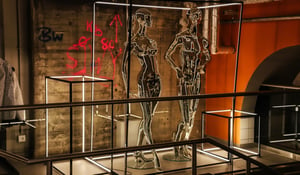Keeping up with the evolution of consumer behavior — just in the past three years alone — is no small feat. Global lockdowns in 2020 transformed how businesses and shoppers interacted, and e-commerce sales surged by more than $244 billion in the first year of the pandemic. Online shopping hasn’t been the only area to see seismic shifts, either.
Supply chain issues have upended markets, economies worldwide have forced shoppers to rethink their purchases, and businesses are implementing omnichannel retail strategies to adapt to changing behaviors. As 2022 winds down and the pandemic fades, consumers are reemerging with different priorities, habits, and ways in which they view shopping.
Today, plenty of consumers still seek out the personalized experience of in-person shopping, and many others have come to favor the convenience and anonymity of online shopping. And, thanks to augmented reality (AR) and other technologies, a third mode of shopping is on the rise that incorporates the best of both worlds: virtual stores.
If you want to sell your products to the modern consumer, you can bridge the physical and digital worlds using emerging technologies that enable immersive shopping experiences.
The rise of virtual stores.
.jpg?width=1920&height=1080&name=Untitled%20design%20(6).jpg)
Virtual stores allow retailers to connect to customers in novel ways, and they have matured beyond digital replicas of physical locations. They are being designed to offer the best of both in-person and online experiences, and they’re evolving into a third mode of shopping that resembles neither stores nor websites.
Powered by AR technology, virtual stores let shoppers interact with merchandise, seek assistance from virtual customer service representatives, and shop in a virtual environment that mimics an in-store experience.
To create a virtual store, you create a three-dimensional, 360-degree e-commerce site that your customers can access through VR platforms like Meta. This type of store offers an enhanced connection to your brand and customer engagement you can’t achieve in traditional e-commerce.
Brands are also using virtual stores to sell products to people in the VR landscape. As more people interact with one another in virtual settings, you can offer your products to their avatars. Brands like H&M and Nike are dressing avatars in the Metaverse and allowing gamers to express themselves inside the virtual world like they would in the real world.
What can your brand do with a virtual store?
If you’re interested in offering a better e-commerce platform to customers buying physical products, a virtual store lets you showcase your products in 3-D. With AR, your customers can “try on” clothing, cosmetics, and other personal items to see how they look and fit. Other applications let your customers virtually interact with products to examine them from all angles and better envision how they would work before they buy.
➜ Personalized Experience
Three-dimensional product pages and AR give your customers a similar experience to that of a brick-and-mortar location, but virtual stores go beyond that. You can also personalize the shopping experience like you can with traditional e-commerce sites.
Customers who enter your virtual store get curated merchandise, product descriptions that address their interests, and advertising that is more likely to appeal to their tastes.
➜ Better Decision-Making Tools
Some customers may hesitate to buy big-ticket items like appliances and furniture online. With a virtual store, they can simulate what these items would look like in their own homes. This virtual tryout makes it easier for your customers to eliminate products that don’t work with their décor or won’t fit into their space.
➜ Easier Searches
You can also use artificial intelligence (AI) and machine learning (ML) to enhance and personalize customer service. When a customer comes into your virtual store and isn’t sure what they’re looking for, the AI-based service tool can help narrow down their choices based on keywords. Maybe your customer is looking for a dress they saw on television. Your virtual assistant can sift through items in that show to narrow their focus.
Understanding whether or not a virtual store is the right move for your brand shouldn’t be a risky and expensive endeavor. This is where Pilot 44 comes in: we’re focused on connecting corporations with startups already innovating in this space, so you don’t have to go it alone and can pilot new ideas faster.
Major brands are using AR in business.
Major brands from Coca-Cola to Adidas are experimenting with different ways to apply AR to the shopping experience. For example, In 2019, Nike launched a virtual pop-up store where customers could purchase limited-edition digital products. Then, in late 2021, the company entered the Metaverse with NIKELAND, a virtual space where digital visitors can play games, interact with one another, and purchase virtual Nike gear for their avatars.
This strategy allows Nike to engage a large, built-in audience in a new way and add a new revenue stream. By appealing to customers in the Metaverse, Nike builds a connection to its brand that extends outside of its usual platforms. Since the company offers digital replications of its physical merchandise, customers can match their virtual avatars in real life.
Startups driving the use of AR technology.
These startup spotlights highlight how AR and emerging technology can be embraced to let users shop for physical products in virtual spaces and leverage virtual stores to enhance gaming and other platforms.
➜ Threedium
Based in the United Kingdom, Threedium is a SaaS startup making 3-D design and augmented reality solutions accessible — and affordable — to retail companies. Threedium helps companies create immersive shopping experiences without the need to hire developers.
The company is known for its engaging 3-D models that enhance and improve the shopping experience. Threedium’s solutions let retailers build out an immersive experience quickly and affordably, enhance their virtual store, and allow customers to interact with virtual products as if they were examining the item in person.
Customers can more easily envision how products fit into their homes and lifestyles, and retailers can build in text and audio annotation to address potential questions and customer objections. Customers can, for example, customize a product to their exact specifications and view the item online before committing to a purchase. They can view product images in an interactive, 360-degree format. They can even use augmented reality to see what a product would look like on their body, in their living room, or even in their office space.
Threedium’s clients include powerhouses like Johnson & Johnson, Nike, and Sainsbury’s, though they offer an affordable plan for companies that need more budgetary flexibility.
Understanding whether or not a virtual store is the right move for your brand shouldn’t be a risky and expensive endeavor. This is where Pilot 44 comes in: we’re focused on connecting corporations with startups already innovating in this space, so you don’t have to go it alone and can pilot new ideas faster.
➜ Haegin
Haegin is a South Korean software company with extensive experience developing games. The company’s popular social networking game, Play Together, has grown in popularity, particularly in Taiwan and Vietnam, and has amassed more than 100 million downloads since its inception.
Play Together is a game based in the Metaverse where users build a virtual community. In the game, users can explore various interests, including gardening, traveling, and fishing, among others. Avatars live in neighborhoods and interact in multiple ways. Recently, Haegin partnered with 7-Eleven to create a virtual convenience store within the game.
The virtual store offers an in-game experience that rivals what customers can expect at a physical 7-Eleven store. A user’s character can buy and consume products commonly sold in real-world stores, and they can even purchase parcel delivery and other game-enhancing services.
Haegin has embraced the concept of a virtual store as a way to boost sales, and they’ve shown that partnering with traditionally in-person retailers on AR projects can be quite innovative — and financially beneficial.
 |
| Haegin’s partnered with 7-ELEVEN Korea to bring the convenience store’s IRL goodies into the metaverse through its social mobile game Play Together |
➜ Fashion League
Fashion League uses AR to bridge fashion and gaming to appeal to a new generation of virtual gamers. According to a study by Mediakix, an influencer marketing agency, women outnumber men in the mobile gaming world. What’s more, women control up to $30 trillion of global consumer spending and are responsible for 80% of all purchasing decisions. To capitalize on this, Fashion League offers these gamers a more enjoyable way to design, interact, and buy NFTs.
Fashion League gamifies the shopping experience and provides a space for users to design, produce, and own their own fashion brand. This platform aims to create an online community and bridge the gap between real-life products and digital creations using augmented reality.
Other AR-assisted brand opportunities.
With a virtual store, you can host branded events and campaigns that aren’t possible in the real world. Whether it’s to boost sales or educate customers, AR’s applications have real-world business benefits.
For example, Nike plans on potentially offering users a chance to virtually attend the Super Bowl or World Cup, making them more accessible to people who may not be able to go in person. Carrefour, a multinational French wholesaling retailer, teaches customers about bees, biodiversity, and sustainability within its social hub. Customers can play fun, bee-themed games to see the pollinators in action and learn their importance in agriculture. The company hopes to drum up interest in the virtual world to get users on board with environmental sustainability and carry their passion into the real world. As a bonus, Carrefour’s efforts in this space demonstrate their Corporate Social Responsibility commitments, helping to strengthen brand affinity and loyalty among customers, especially Millennials and Gen Z, who seek greater authenticity and purpose-driven values from the brands they patronize.
How Pilot 44 can help you.
Pilot 44 helps brands like yours understand how emerging technologies can help you connect to existing and potential customers in new and exciting ways. We will work with you to understand how to use and deploy these technologies to attract new customers and boost your ROI. You don’t have to have an in-depth knowledge of AR, blockchain, and other technologies. You only need a vision and the desire to innovate as internet technology evolves.
Together, we can help your brand run a fast-cycle, in-market pilot that lets you stand out while engaging your customers in new, creative ways.
Learn how Pilot 44 can help you get ahead of the competition, leverage tomorrow’s technology today and navigate the future of consumer engagement.




